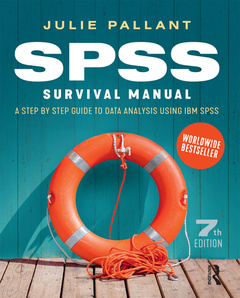SPSS Survival Manual (7th Ed.) A step by step guide to data analysis using IBM SPSS
Auteur : Pallant Julie

The SPSS Survival Manual throws a lifeline to students and researchers grappling with this powerful data analysis software.
In her bestselling manual, Julie Pallant guides you through the entire research process, helping you choose the right data analysis technique for your project. From the formulation of research questions, to the design of the study and analysis of data, to reporting the results, Julie discusses basic through to advanced statistical techniques. She outlines each technique clearly, providing step by step procedures for performing your analysis, a detailed guide to interpreting data output and examples of how to present your results in a report.
For both beginners and experienced users in psychology, sociology, health sciences, medicine, education, business and related disciplines, the SPSS Survival Manual is an essential text. Illustrated with screen grabs, examples of output and tips, it is supported by a website with sample data and guidelines on report writing.
This seventh edition is fully revised and updated to accommodate changes to IBM SPSS Statistics procedures, screens and output.
A website with support materials for students and lecturers is available at https://routledgetextbooks.com/textbooks/9781760875534/
Preface
Data files and website
Introduction and overview
Part One Getting started
1 Designing a study
2 Preparing a codebook
3 Getting to know IBM SPSS Statistics
Part Two Preparing the data file
4 Creating a data file and entering data
5 Screening and cleaning the data
Part Three Preliminary analyses
6 Descriptive statistics
7 Using graphs to describe and explore the data
8 Manipulating the data
9 Checking the reliability of a scale
10 Choosing the right statistic
Part Four Statistical techniques to explore relationships among variables
11 Correlation
12 Partial correlation
13 Multiple regression
14 Logistic regression
15 Factor analysis
Part Five Statistical techniques to compare groups
16 Non-parametric statistics
17 T-tests
18 One-way analysis of variance
19 Two-way between-groups ANOVA
20 Mixed between-within subjects analysis of variance
21 Multivariate analysis of variance
22 Analysis of covariance
Appendix: Details of data files
Recommended reading
References
Index
Date de parution : 03-2020
20.3x25.4 cm
Date de parution : 03-2021
20.3x25.4 cm
Thème de SPSS Survival Manual :
Mots-clés :
Internal States Scale; data analysis; Graduate Diploma Students; factor analysis; Perceived Stress Scores; preliminary analyses; Listwise Exclusion; partial correlation; Marlowe Crowne Social Desirability Scale; IBM SPSS statistics; Friedman Test; Partial Eta Squared; Data Editor Window; Data Set; Sav Data File; Chart Editor Window; APA Style; Eta Squared; Wilcoxon Signed Rank Test; Perceived Stress Scale; Optimism Scores; Missing Values; Higher Order Factorial Designs; Post-hoc Tests; Case Processing Summary Table; Effect Size Statistics; Statistics Test Scores; Data View Tab; Pivot Table; Preliminary Assumption Testing



